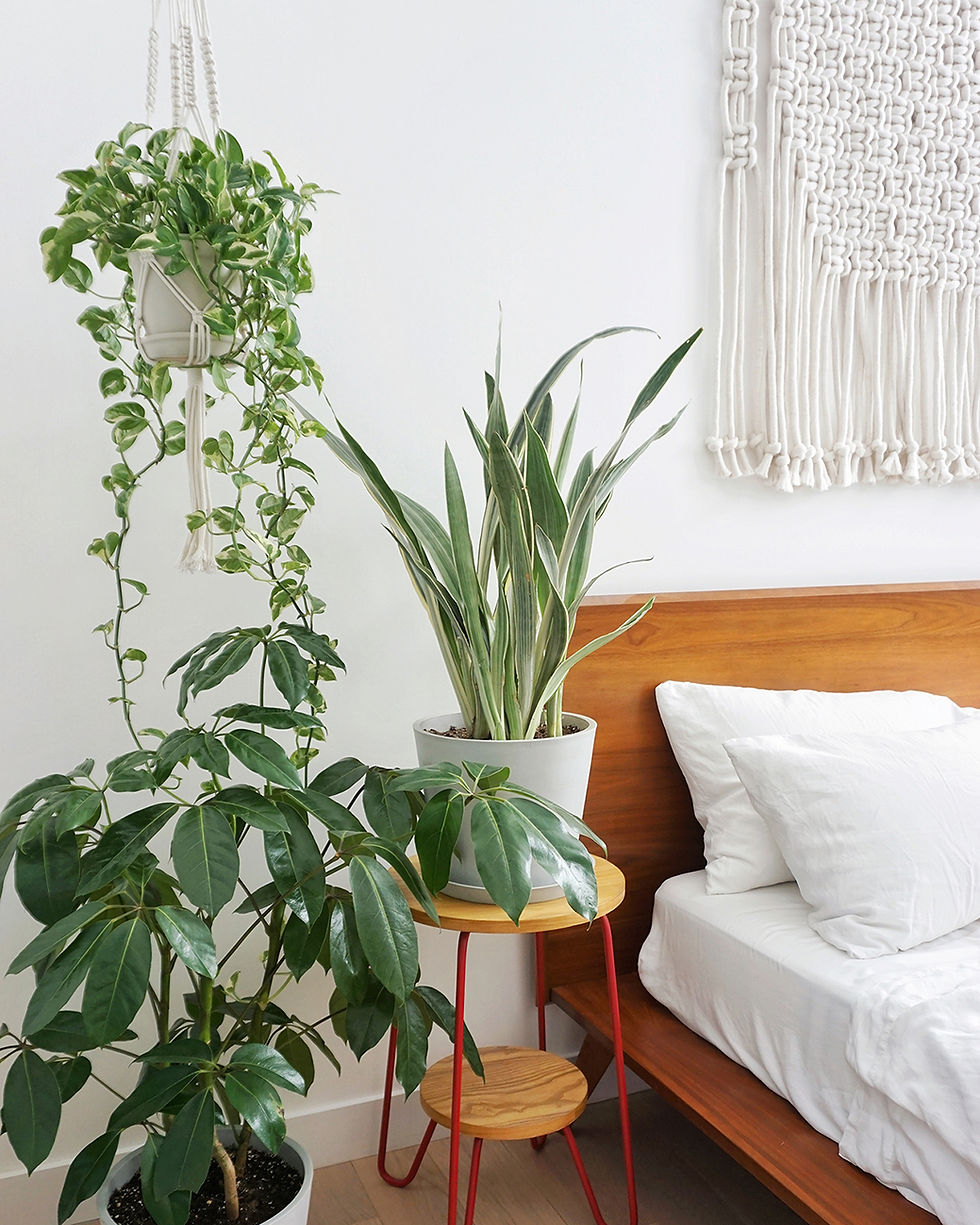Plant Parenting 101
- Trinity Shi

- Jan 18, 2021
- 4 min read
Updated: Aug 29
The rising popularity of houseplants means an influx of new plant parents! Welcome to Plant Parenting 101, where I'll be sharing some tips to help you add more green to your home. In this post I will cover the following: how to pick the right plant for your space, how to check and treat common pests, how to water your plants, and how to pot up/repot your plant.

CHOOSING THE RIGHT PLANT FOR YOUR SPACE
Before purchasing houseplants, consider your available lighting. Does your place have bright, medium, or low light? The most optimal bright light will be from south-facing and west-facing windows. East-facing windows will get some decent morning sun, but north-facing windows will get the least amount of light.
If you have lots of bright light, many plant options are available to you: monsteras, bird of paradise, ficus/rubber trees, hoyas, and even succulents and cacti. There are many plants that can tolerate medium to low light, such as Chinese evergreen, snake plants, pothos, and ZZ plants. If you have insufficient light, consider using grow lights. You can find grow light bulbs online or at many hardware stores. If you want to invest in a high-quality grow light, I recommend the Soltech Solutions grow lights. (You can use code "BRIGHT15" for 15% off your purchase).
If you have pets, another factor to consider is the toxicity of certain plants. Many plants can be toxic if your cat or dog ingests the leaves or sap. Luckily I have a cat who has never tried to eat my plants, but if your furry child loves to nibble, then consider pet-safe options. There are many pet-safe options like calatheas, spider plants, peperomias, and orchids. Do a google search if you're unsure.

CHECKING FOR PESTS
Before you purchase from a nursery, check the plant and make sure it doesn't have any visible pests. Common pests include: spider mites, mealy bugs, and scale. There can also be fungal issues and over-watering which causes root rot. Look under the leaves to see if anything is moving. Check the stems to see if there are any strange bumps. Are there any unhealthy leaves or leaf-damage? All of those can be tell-tale signs that there may be issues.
If you want to be extra safe when bringing a new plant home, you can quarantine it away from your other plants for 1-2 weeks. You can isolate the plant and treat the issues. Common pests like spider mites can be treated with a need oil spray or my favorite, End-All spray. Mealy bugs can be wiped away with alcohol. You may need multiple treatments to control infestations. If the problem is severe, you will need to uproot and soak/wash in insecticidal soap and pot up in new soil.
Another issue plant parents experience is the omnipresent fungus gnat! They lay their eggs in the soil and the adults fly around from plant to plant. The gnats will not harm the plant, but they are extremely annoying. You can control the adults with sticky traps. I like to mix some Systemic Insect Control Granules into the soil to control the gnat larvae. I also spray Deadbug Brew on the top soil about once a month.
WATERING YOUR PLANTS
Figuring out the watering schedule is important and depends on factors like your room humidity as well as the soil and pot size your plant is in. Monsteras and hoyas tend to like the soil to dry out a bit in-between watering. Snake plants are very drought-tolerant and only need to be watered a couple times per month. Make sure to research water needs of your plant online.
Some plant parents like to use a moisture meter to check if they need to water their plant. I personally prefer to poke my finger into the soil to feel if it's dry. Once you get the hang of watering based on your plant's needs, you'll be able to have a more intuitive watering schedule.
Remember that larger pots will dry out slower than small pots. If you're unsure about the moisture, it's always better to water less instead of risking over-watering (which leads to root rot). You can also plant in terra cotta, which is a porous material that will help water evaporate faster.

POTTING YOUR PLANTS
Most plants will come in a plastic nursery pot from the store. These pots already have drainage holes and can be placed directly in a decorative pot without drainage. The outer pot will serve as a cachepot to hide the plastic pot. When watering, make sure to empty the cachepot if there's any access water that drains from the nursery pot.
If you want to plant directly into a pot, make sure the new pot has drainage. Choose a pot that is the same size or slightly larger than the original pot. That way you won't have a small plant in a giant pot, which will cause the soil to remain wet for longer and increase chances of root rot. As mentioned before, terra cotta pots will dry out faster than glazed pots. When the roots have grown out from the bottom drainage holes, it will be a sign to repot into a larger pot! When planting into pots with drainage, remember to use a tray or saucer underneath to protect your floors and surfaces from water damage.
HAPPY PLANTING AND ENJOY YOUR PLANT PARENTHOOD!
For more plant styling and design inspo, follow @cubehousejungle on instagram!




Comments